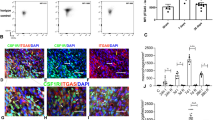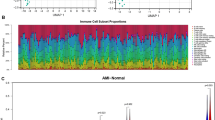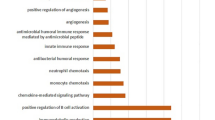Abstract
We mapped a gene predisposing to myocardial infarction to a locus on chromosome 13q12–13. A four-marker single-nucleotide polymorphism (SNP) haplotype in this locus spanning the gene ALOX5AP encoding 5-lipoxygenase activating protein (FLAP) is associated with a two times greater risk of myocardial infarction in Iceland. This haplotype also confers almost two times greater risk of stroke. Another ALOX5AP haplotype is associated with myocardial infarction in individuals from the UK. Stimulated neutrophils from individuals with myocardial infarction produce more leukotriene B4, a key product in the 5-lipoxygenase pathway, than do neutrophils from controls, and this difference is largely attributed to cells from males who carry the at-risk haplotype. We conclude that variants of ALOX5AP are involved in the pathogenesis of both myocardial infarction and stroke by increasing leukotriene production and inflammation in the arterial wall.
This is a preview of subscription content, access via your institution
Access options
Subscribe to this journal
Receive 12 print issues and online access
$259.00 per year
only $21.58 per issue
Buy this article
- Purchase on SpringerLink
- Instant access to full article PDF
Prices may be subject to local taxes which are calculated during checkout



Similar content being viewed by others
References
Bonow, R.O., Smaha, L.A., Smith, S.C. Jr., Mensah, G.A. & Lenfant, C. World Heart Day 2002: the international burden of cardiovascular disease: responding to the emerging global epidemic. Circulation 106, 1602–1605 (2002).
Heart Disease and Stroke Statistics, 2003 Update (American Heart Association, Dallas, Texas, 2002).
Lusis, A.J. Atherosclerosis. Nature 407, 233–241 (2000).
Libby, P. Inflammation in atherosclerosis. Nature 420, 868–874 (2002).
Stratford, N., Britten, K. & Gallagher, P. Inflammatory infiltrates in human coronary atherosclerosis. Atherosclerosis 59, 271–276 (1986).
Poole, J.C. & Florey, H.W. Changes in the endothelium of the aorta and the behaviour of macrophages in experimental atheroma of rabbits. J. Pathol. Bacteriol. 75, 245–251 (1958).
Topol, E.J. et al. Single nucleotide polymorphisms in multiple novel thrombospondin genes may be associated with familial premature myocardial infarction. Circulation 104, 2641–2644 (2001).
Ozaki, K. et al. Functional SNPs in the lymphotoxin-alpha gene that are associated with susceptibility to myocardial infarction. Nat. Genet. 32, 650–654 (2002).
Yamada, Y. et al. Prediction of the risk of myocardial infarction from polymorphisms in candidate genes. N. Engl. J. Med. 347, 1916–1923 (2002).
Broeckel, U. et al. A comprehensive linkage analysis for myocardial infarction and its related risk factors. Nat. Genet. 30, 210–214 (2002).
Francke, S. et al. A genome-wide scan for coronary heart disease suggests in Indo-Mauritians a susceptibility locus on chromosome 16p13 and replicates linkage with the metabolic syndrome on 3q27. Hum. Mol. Genet. 10, 2751–2765 (2001).
Harrap, S.B. et al. Genome-wide linkage analysis of the acute coronary syndrome suggests a locus on chromosome 2. Arterioscler. Thromb. Vasc. Biol. 22, 874–878 (2002).
Pajukanta, P. et al. Two loci on chromosomes 2 and X for premature coronary heart disease identified in early- and late-settlement populations of Finland. Am. J. Hum. Genet. 67, 1481–1493 (2000).
Wang, L., Fan, C., Topol, S.E., Topol, E.J. & Wang, Q. Mutation of MEF2A in an inherited disorder with features of coronary artery disease. Science 302, 1578–1581 (2003).
Dixon, R.A. et al. Requirement of a 5-lipoxygenase-activating protein for leukotriene synthesis. Nature 343, 282–284 (1990).
Mehrabian, M. et al. Identification of 5-lipoxygenase as a major gene contributing to atherosclerosis susceptibility in mice. Circ. Res. 91, 120–126 (2002).
Brezinski, D.A., Nesto, R.W. & Serhan, C.N. Angioplasty triggers intracoronary leukotrienes and lipoxin A4. Impact of aspirin therapy. Circulation 86, 56–63 (1992).
Spanbroek, R. et al. Expanding expression of the 5-lipoxygenase pathway within the arterial wall during human atherogenesis. Proc. Natl. Acad. Sci. USA 100, 1238–1243 (2003).
The World Health Organization MONICA Project (monitoring trends and determinants in cardiovascular disease): a major international collaboration. WHO MONICA Project Principal Investigators. J. Clin. Epidemiol. 41, 105–14 (1988).
Koshino, T. et al. Novel polymorphism of the 5-lipoxygenase activating protein (FLAP) promoter gene associated with asthma. Mol. Cell. Biol. Res. Commun. 2, 32–35 (1999).
Sala, A., Bolla, M., Zarini, S., Muller-Peddinghaus, R. & Folco, G. Release of leukotriene A4 versus leukotriene B4 from human polymorphonuclear leukocytes. J. Biol. Chem. 271, 17944–17948 (1996).
Dahinden, C.A., Clancy, R.M., Gross, M., Chiller, J.M. & Hugli, T.E. Leukotriene C4 production by murine mast cells: evidence of a role for extracellular leukotriene A4. Proc. Natl. Acad. Sci. USA 82, 6632–6636 (1985).
Fiore, S. & Serhan, C.N. Formation of lipoxins and leukotrienes during receptor-mediated interactions of human platelets and recombinant human granulocyte/macrophage colony-stimulating factor-primed neutrophils. J. Exp. Med. 172, 1451–1457 (1990).
Ford-Hutchinson, A.W. Leukotriene B4 in inflammation. Crit. Rev. Immunol. 10, 1–12 (1990).
Samuelsson, B. Leukotrienes: mediators of immediate hypersensitivity reactions and inflammation. Science 220, 568–575 (1983).
Burke, J.A., Levi, R., Guo, Z.G. & Corey, E.J. Leukotrienes C4, D4 and E4: effects on human and guinea-pig cardiac preparations in vitro. J. Pharmacol. Exp. Ther. 221, 235–241 (1982).
Roth, D.M. & Lefer, A.M. Studies on the mechanism of leukotriene induced coronary artery constriction. Prostaglandins 26, 573–581 (1983).
Wargovich, T., Mehta, J., Nichols, W.W., Pepine, C.J. & Conti, C.R. Reduction in blood flow in normal and narrowed coronary arteries of dogs by leukotriene C4. J. Am. Coll. Cardiol. 6, 1047–1051 (1985).
Falk, E., Shah, P.K. & Fuster, V. Coronary plaque disruption. Circulation 92, 657–671 (1995).
Dwyer, J.H. et al. Arachidonate 5-Lipoxygenase Promoter Genotype, Dietary Arachidonic Acid, and Atherosclerosis. N. Engl. J. Med. 350, 29–37 (2004).
Aiello, R.J. et al. Leukotriene B4 receptor antagonism reduces monocytic foam cells in mice. Arterioscler. Thromb. Vasc. Biol. 22, 443–449 (2002).
Gretarsdottir, S. et al. The gene encoding phosphodiesterase 4D confers risk of ischemic stroke. Nat. Genet. 35, 131–138 (2003).
Gretarsdottir, S. et al. Localization of a susceptibility gene for common forms of stroke to 5q12. Am. J. Hum. Genet. 70, 593–603 (2002).
Gudmundsson, G. et al. Localization of a gene for peripheral arterial occlusive disease to chromosome 1p31. Am. J. Hum. Genet. 70, 586–592 (2002).
Gulcher, J.R., Kristjansson, K., Gudbjartsson, H. & Stefansson, K. Protection of privacy by third-party encryption in genetic research in Iceland. Eur. J. Hum. Genet. 8, 739–742 (2000).
Kong, A. & Cox, N.J. Allele-sharing models: LOD scores and accurate linkage tests. Am. J. Hum. Genet. 61, 1179–1188 (1997).
Gudbjartsson, D.F., Jonasson, K., Frigge, M.L. & Kong, A. Allegro, a new computer program for multipoint linkage analysis. Nat. Genet. 25, 12–13 (2000).
Kong, A. et al. A high-resolution recombination map of the human genome. Nat. Genet. 31, 241–247 (2002).
Whittemore, A.S. & Halpern, J. A class of tests for linkage using affected pedigree members. Biometrics 50, 118–127 (1994).
Kruglyak, L., Daly, M.J., Reeve-Daly, M.P. & Lander, E.S. Parametric and nonparametric linkage analysis: a unified multipoint approach. Am. J. Hum. Genet. 58, 1347–1363 (1996).
Nicolae, D. Allele Sharing Models in Gene Mapping: A Likelihood Approach (University of Chicago, 1999).
Dempster, A., Laird, N.M. & Rubin, D.B. Maximum likelihood from incomplete data via the EM algorithm. J. R. Stat. Soc. B 39, 1–38 (1977).
Terwilliger, J.D. & Ott, J. A haplotype-based 'haplotype relative risk' approach to detecting allelic associations. Hum. Hered. 42, 337–346 (1992).
Falk, C.T. & Rubinstein, P. Haplotype relative risks: an easy reliable way to construct a proper control sample for risk calculations. Ann. Hum. Genet. 51 Pt 3, 227–233 (1987).
Lewontin, R.C. The interaction of selection and linkage. ii. Optimum models. Genetics 50, 757–782 (1964).
Hill, W.G. & Robertson, A. The effects of inbreeding at loci with heterozygote advantage. Genetics 60, 615–628 (1968).
Chen, X., Zehnbauer, B., Gnirke, A. & Kwok, P.Y. Fluorescence energy transfer detection as a homogeneous DNA diagnostic method. Proc. Natl. Acad. Sci. USA 94, 10756–10761 (1997).
Steeds, R., Adams, M., Smith, P., Channer, K. & Samani, N.J. Distribution of tissue plasminogen activator insertion/deletion polymorphism in myocardial infarction and control subjects. Thromb. Haemost. 79, 980–984 (1998).
Brouilette, S., Singh, R.K., Thompson, J.R., Goodall, A.H. & Samani, N.J. White cell telomere length and risk of premature myocardial infarction. Arterioscler. Thromb. Vasc. Biol. 23, 842–846 (2003).
Nomenclature and criteria for diagnosis of ischemic heart disease. Report of the Joint International Society and Federation of Cardiology/World Health Organization task force on standardization of clinical nomenclature. Circulation 59, 607–609 (1979).
Acknowledgements
We thank the affected individuals and their families whose contribution made this study possible and the nurses at the Icelandic Heart Association, personnel at the deCODE core facilities, T. Jonsdottir, F. Runarsson, E. Palsdottir, J. Kostic, K. Channer, R. Steeds, R. Singh and P. Braund for their contributions. N.J.S. is supported by the British Heart Foundation.
Author information
Authors and Affiliations
Corresponding author
Ethics declarations
Competing interests
Some authors are employed by deCODE genetics, and some of them own stock options in the company
Supplementary information
Rights and permissions
About this article
Cite this article
Helgadottir, A., Manolescu, A., Thorleifsson, G. et al. The gene encoding 5-lipoxygenase activating protein confers risk of myocardial infarction and stroke. Nat Genet 36, 233–239 (2004). https://doi.org/10.1038/ng1311
Received:
Accepted:
Published:
Issue date:
DOI: https://doi.org/10.1038/ng1311
This article is cited by
-
Population history modulates the fitness effects of Copy Number Variation in the Roma
Human Genetics (2023)
-
Pharmacokinetics, Pharmacodynamics, and Tolerability of AZD5718, an Oral 5-Lipoxygenase-Activating Protein (FLAP) Inhibitor, in Healthy Japanese Male Subjects
Clinical Drug Investigation (2021)
-
First-degree relatives with similar phenotypic characterisation of acute myocardial infarction: a case report and review of the literature
BMC Cardiovascular Disorders (2019)
-
Expression profiles of long noncoding RNAs and messenger RNAs in the border zone of myocardial infarction in rats
Cellular & Molecular Biology Letters (2019)
-
Monogenic, Polygenic, and MicroRNA Markers for Ischemic Stroke
Molecular Neurobiology (2019)



